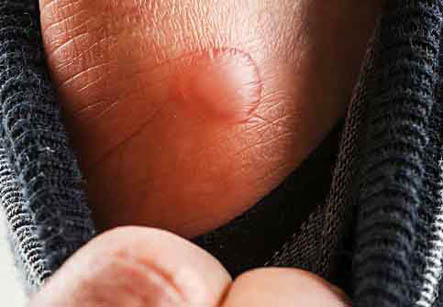Edema Blister
Introduction
Edema blisters (also known as Edema bulla, Hydrostatic bulla, and Stasis blister) are a cutaneous condition mostly common in lower extremities which occur acutely in patients with systemic diseases. The fluids that get trapped under the skin surface form the edema blisters. The blisters develop commonly in elderly, immobile and long term hospitalized patients.
Features
1. Edema blisters are generally an acute exacerbation of chronic edema
2. They occur particularly in the lower extremities in the setting of anasarca or generalized edema.
3. The lesions are fluid-filled, tense and non-inflammatory.
4. Edema blisters are surrounded by edematous skin.
5. Blisters resolve when the underlying cause of edema is treated.
Edema blisters (also known as "Edema bulla", "Hydrostatic bulla," and "Stasis blister") are a cutaneous condition that develop in patients with an acute exacerbation of chronic edema, particularly of the lower extremities, and in the setting of anasarca

Causes
1. Edema develops when the capillary filtration rate exceeds lymphatic drainage.
2. The cause of this can be conditions like heart failure, chronic renal disease, liver cirrhosis, hypoproteinemia, venous thrombosis.
3. Some medications can cause edema. Drugs like calcium channel blockers used for treating blood pressure, thiazolidinediones used for treatment of diabetes, and nonsteroidal anti-inflammatory drugs also can cause water retention.
4. Rare reasons may be excessive salty diet, hormonal changes in premenstrual syndrome, or pregnancy.
Symptoms of Water Retention
Blisters on the skin are a sign of severe water retention. This is caused by accumulation of fluid trapped under the skin surface.
Other symptoms of water retention are
1. Swelling of the ankles, legs, face or other areas of the body.
2. Pitting edema means a noticeable dimple is formed and remains for some time at the site where pressure is applied to the skin by fingers.
3. Shiny and stretched look of the skin.
4. A significant and unexplained increase in the size of the abdomen. In severe cases, the abdomen is very tense and bulging.
5. The serious Symptoms of water retention are difficulty in breathing, chest pain and shortness of breath. These symptoms suggest a life-threatening condition called as pulmonary edema or water retention in lungs. The patient should seek immediate medical help if these symptoms develop.
Treatment of Edema Blisters
1. The small blisters need not be treated as they heal on their own. They usually contain sterile or non-infected fluid. They tend to break within a few days as they have thin roof and are tense.
2. The area of blisters should be kept dry and clean. The watery fluid gets absorbed slowly over time. They can be covered in bandages to prevent unwanted friction or pressure till they heal.
3. Once the fluid imbalance is corrected, these blisters resolve without recurrence.1 If the blisters are located on a distal portion of the lower extremities, elevation of the legs can reduce the edema and subsequent blister formation.
4. Pressure stockings can be prescribed to wear by the doctor as these stockings squeeze the fluid in the legs and also prevent further water retention.
5. Resting with legs raised above the heart level can help in drainage of excessive fluid from the legs by boosting venous as well as lymphatic system. This is useful particularly for blisters on distal part of the legs.
6. Limiting salt in the diet can be recommended by the doctor to help in reducing the retention.
7. Sitting or standing in one place for a long period of time should be avoided. The movements of leg muscles tend to increase the circulation in the lower limb and can reduce the edema.
8. Leakage of fluid from the capillaries can signal the kidneys to slower the production of urine. This in turn causes more fluid to build up in the body and more pressure in the capillaries. This causes more leakage from the capillaries and the cycle repeats. Low levels of protein called albumin in blood can also signal the kidneys will to retain more sodium and fluid. The doctor prescribes medications to prevent retention and these are called as diuretics which help the kidneys to increase the formation of urine.
9. When the blisters show signs of infection like pain, redness, more swelling and fever, antibiotics are needed for its treatment. Vitamin supplements help in some cases.
10. If the blister is large and painful, drainage of the contents of blister is required. The doctor first cleans the area thoroughly and makes a nick on the most prominent point of the blister. To help in removal of all fluid inside, a gentle pressure is applied on the broken blister. An antibiotic ointment is applied and the site is closed with bandages.
However, treatment of cause is the most important intervention for treating the edema blisters. Early and appropriate management of heart failure, liver cirrhosis and kidney disorders, correcting hypoproteinemia as well as changing the drug causing edema with a better one remain the cornerstones of edema blister resolution.